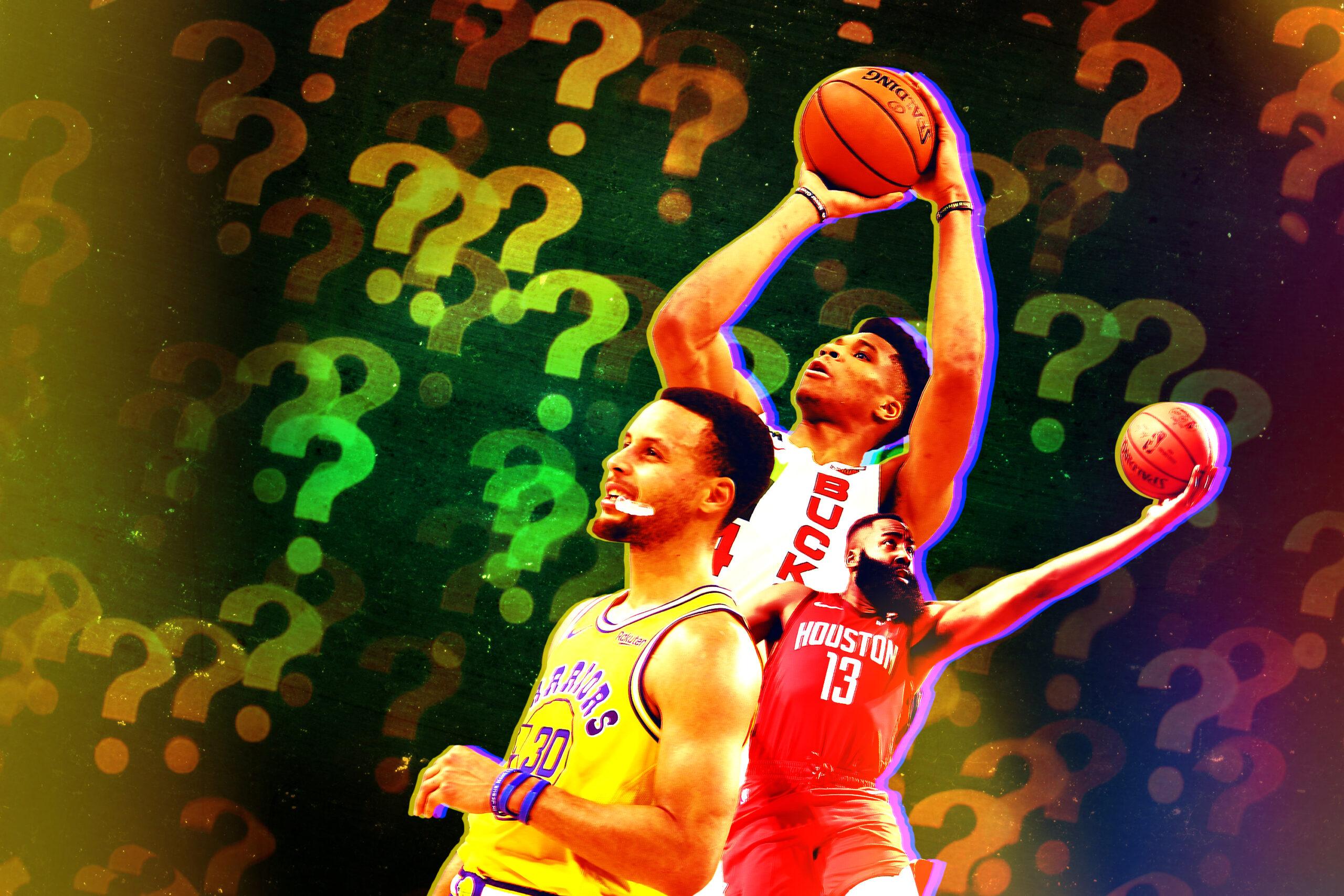
Don’t look now, but the league is fast approaching the halfway mark in the season. With the new year upon us, it’s helpful to dig into some of the biggest questions the NBA has left to answer the rest of the way.
Has the MVP Hunt Become a Two-Man Race?
With the best winning percentage in the league and a stranglehold on the NBA’s best net rating, the Milwaukee Bucks will be a popular fixture during awards season in several categories. They might also be mathematical favorites to win it all, at least according to one aggregation of a million different full-season simulations. The Bucks are a near-perfect regular-season team, an intoxicating blend of speed, modern shot topography, elite two-way efficiency, and star power. And if history is any indication, their biggest star will likely be rewarded with the highest individual honor in the sport.
The MVP award has been given to the best player on the team with the best regular-season record in seven of the past 10 seasons. So, should things hold, Giannis Antetokounmpo will be the favorite in that regard (Kawhi Leonard is certainly a dark horse, but by the end of the season may miss too many games to be a legitimate consideration). But Giannis’s case is more than just a product of team success. Antetokounmpo is having a historically good campaign, with averages in points, rebounds, and assists that haven’t been matched in nearly six decades. Oscar Robertson is the only player in NBA history to finish a season averaging at least 26 points, 12 rebounds, and six assists per game in his legendary triple-double 1961-62 sophomore campaign with the Cincinnati Royals. He needed to average 44 minutes per game to log those kinds of numbers; Giannis, thus far, by virtue of all the games the Bucks are blowing out, has required only 34.
In two of the three years over the past 10 seasons when the MVP didn’t go to the best player on the best team, it went to Russell Westbrook and LeBron James—two players who have routinely broken the concept of statistical norms. Nikola Jokic fits the mold as a center with the statistical profile of a star point guard, but it might not be gaudy enough; Joel Embiid’s numbers are outrageous, but the Sixers have been treading water in the standings. To win on the merits of individual achievement rather than overall team success, the stats have to be undeniable. From that perspective, the second horse in this race is clear.
You’ve probably seen the numbers, though they aren’t particularly believable. The Rockets are the hottest team of the past 10 games at 9-1, and James Harden is essentially the entire reason. He has more or less willed the team back into the top half of the playoff picture by himself, averaging a staggering 40.8 points (attempting 13.8 3-pointers per game on 41.3 percent shooting!), 6.8 rebounds, and 8.9 assists per game in that span. Harden is currently averaging 33.3 points per game on the season, which would be the highest single-season scoring average since Kobe Bryant’s 2005-06 Rambo season, wherein he dropped 35.4 points nightly.
For Harden to match Kobe’s numbers from that year, he’d have to average exactly 37 points over Houston’s remaining 46 games. To be honest, he might have to average that regardless. There is no updated timetable on Chris Paul’s return from his recurring left hamstring injury, and with an obscene amount of money invested in the 33-year-old point guard’s next three seasons, the Rockets won’t be rushing him back. All the more room for Harden to cement his MVP case the old-fashioned way.
What Will the Warriors Look Like Once They Flip the Switch?
The concern-troll buzzword of the 2017-18 season was “fatigue.” Past dynasties well within the grasp of recent memory had seen their team disintegrate under the pressure of four consecutive Finals appearances. The Warriors held firm and won their third title in four seasons, but that fifth appearance eludes all but the greatest dynasties the league has ever seen. Fatigue may no longer be how we frame the struggles, but their challenges over the past four campaigns compound with every year; the fatigue has gotten worse, and now their biggest impediment seems to be the Kevin Durant–sized unknown that lies just beyond the end of the season.
This is the least focused we’ve seen the Warriors. It might not matter. The team knows it can sleepwalk into the playoffs; it knows how tough an out it is in a seven-game series. But as Steph Curry mentioned last month, the Warriors’ margin for error is slimmer this season. They’ve left themselves vulnerable as they’ve tried to reestablish the kind of rhythm that turns a lineup with three of the greatest shooters the sport has ever seen into an unsolvable puzzle for the NBA. That’s meant a lot of midrange shots, more than even last season, when their accuracy from the league’s modern dead zone became a sort of taunting mechanism. They’d always hit enough 3s to make their midrange proclivities work in the past, but these days it seems as though the Warriors are trying to find themselves by being a different team completely. Those shots from 16 feet are meant to instill confidence rather than exude it.
At 25-13, the Warriors are still second in the West and are not in danger of dropping out completely, barring catastrophe. The imminent arrival of DeMarcus Cousins could be the galvanizing property the Warriors have sorely needed, especially with all the injuries the team has dealt with at center. But incorporating a player like Boogie, who has spent the past 11 months rehabbing a ruptured Achilles tendon, might be the biggest adjustment in a season full of them. The most important question about Cousins to the Warriors as a franchise might be whether he’ll be able to meet the demands that Golden State has traditionally asked of its 5s. Cousins’s adjustment will be not only fitting in with the most talented roster he’s ever been on, but also reconciling who he is and who he was. In a sense, he is back to his earliest years with the Sacramento Kings, trying to bridge the divide between the skills he knows he has and what he’s physically able to execute in games. It’s yet another layer of complications for a team that hasn’t found its form for much of the season.
When Will the Dust Finally Settle in the West?
With apologies to the Eastern Conference—which, with the startlingly good Indiana Pacers surging on the back of a stifling defense, is now five-deep—there is no contest for which of the two conferences is producing the most intrigue this season.
Seven of the eight Western Conference teams that made the playoffs last season were in playoff position on New Year’s Day 2018. The separation between first and 14th place in the West was 17 games. Fast-forward one full year, and there is no sense of stability in the West for anyone. Four and a half games separate first place and eighth place; 8.5 games separate first place and 14th place—exactly one half the number of games compared with last season.
The playoff race out West remains historically close. The numbers bear it out, but it’s the narrative that brings tensions to a boiling point: Under the crucible of LeBron James, the young Lakers are forced to play every game as though it is their last; the Rockets, who got off to a turbulent 11-14 start, have almost zero margin for error with one star on the sidelines, two important defenders on other teams, and a league that has co-opted its once nonconformist offensive philosophies. And those are two teams that were expected to be shoo-ins for playoff spots. Plus, the best team in the conference is the Nuggets, who haven’t been to the postseason in five years, and some of the worst teams in the league last season (Grizzlies, Kings, Mavericks) are right in the thick of the action this time around. The tension is only building. It’s going to be a nauseating second half of the season.
Will We Get a Season-Swinging Trade at the Deadline?
Related: With the Warriors perhaps more vulnerable than they’ve been in the past four years, and gridlock in the standings, February’s trade deadline seems more consequential than usual. There’s always one team transparent about its need to make a splash—it was Cleveland last year—but this season, that pressure applies to more than a handful of teams. Perhaps we’ve already met our superstar quota with the Sixers trading for Jimmy Butler. But it would be a complete shock if there weren’t at least a couple of big transactions made in the coming weeks. In a season that could end a dynasty and chart a new direction in the league, contenders have to be looking for their next edge, tankers have to be looking for what assets they can gather for their used goods, and teams on the cusp of playoff contention have to find an extra fuse for their second-half propulsion. (For more trade thoughts, read Kevin O’Connor’s early trade primer from last month.)
My personal wish list: Kentavious Caldwell-Pope lands with the Rockets in a convoluted three-team trade; Otto Porter Jr. finds a new home with a playoff contender; Dewayne Dedmon gets traded to a team that lets him do the whole Brook Lopez thing from behind the arc. (What can I say? I’m a man of little ambition.)
Are the 2019 Tank Wars Even Fiercer Than Last Year’s?
As The Ringer’s biggest tanking enthusiast, the draft lottery reform that passed last season to smooth out lottery odds at the top left me crestfallen. Tanking, as I’ve long stated, is the best thing about the regular season. It is a natural byproduct of the way in which the league incentivizes team-building that gives hope through unconventional means, not unlike how compost made of naturally rotting waste is an extremely effective fertilizer. Tanking creates a subcutaneous layer of intrigue in the NBA right around the time when March Madness is foisted upon us and the doldrums of a terribly long regular season begin to set in. It is, in my view, essential to the idea of the NBA as a yearlong center of attention. To discourage tanking is to discourage hope for nearly half of the league.
So, as we approach the NBA’s midterms, it’s delighted me to no end that tanking is not only alive, but thriving. At this time last season, the Hawks were the worst team in the NBA, with a .278 win percentage (10-26). So far this season, there are four teams (Cavaliers, Suns, Knicks, Bulls) with a lower win percentage than the 2017-18 Hawks, which boasted one of the least talented rosters I’d ever seen.
Last season’s tank wars were almost as close as the Western Conference playoff race this season: Only six games separated the worst record in the league from the seventh-worst. That’s the smallest disparity since 1997; the second-closest came in both the 2001-02 and 2012-13 seasons, when nine games separated worst and seventh-worst. The putridity of this year’s race is concentrated in the bottom five. (As things stand, the Cavs, Suns, and Knicks are all on pace to lose more games than last season’s league-worst Suns.)
With the lottery odds flattened, it’s become even less likely that the league’s absolute dregs will obtain the crown jewel of the draft, but tanking is more than just a calculated play at probability. It’s something more holistic; the idea of inviting misery in can feel like accumulating good karma. The more it hurts, the closer to Zion Williamson you feel.

